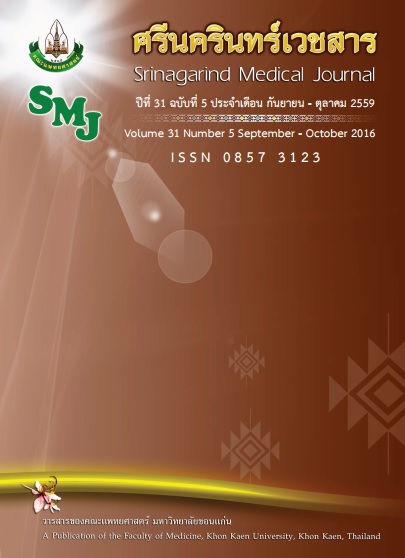Clinical Significance of Atypical Squamous Cells, Cannot Exclude High Grade Squamous Intraepithelial Lesions (ASC-H) Cytological Abnormalities in Premenopausal and Postmenopausal Women
Keywords:
ASC-H, cervical cytology, menopausal status, postmenopausal womenAbstract
Background and Objective: Diagnosis of ASC-H category is difficult. The incidence of CIN2 or greater in ASC-H cytology varies greatly among different areas. In postmenopausal women associated with secondary changes, such as atrophy from hypoestrogenic status. This finding could affect ASC-H interpretation and the outcome of ASC-H cytology, resulting in unnecessary procedures that can lead to increased complications and cost.
Methods: Women who had cervical cytology featuring ASC-H and who underwent colposcopy at Maharat Nakhon Ratchasima hospital from January 2008 to December 2014 were included in the study. Data were collected from medical records. The data consisted of patient characteristics, colposcopic findings, histopathology on colposcopically directed biopsy (CDB) or subsequent loop electrosurgical excision procedure (LEEP) and hysterectomy. The statistical analysis was carried out using standard computer software.
Results: From 210 cases of ASC-H, 120 were premenopausal women (57%) and 90 were postmenopausal women (43%). The histologic diagnosis revealed no squamous intraepithelial lesion (SIL) in 89 cases (42.4%), CIN1 in 22 cases (10.5%), CIN2 in 16 cases (7.6%), CIN3 in 46 cases (21.9%) and invasive cancer in 37 cases (17.6%). The detection of histologically confirmed CIN2 or greater in premenopausal women for 71 cases (59.2%) and in postmenopausal women for 28 cases ( 31.1%). The risk of CIN2 or greater in premenopausal women was more than postmenopausal women (adjusted odd ratio: 7.07, 95 % CI : 2.72, 18.40). The risk factors associated with CIN2 or greater in postmenopausal women were age > 55 years and BMI > 23 kg. /m.2
Conclusions: Premenopausal women with ASC-H cytology were at higher risk for CIN2 or greater than postmenopausal women. In premenopausal women with histologic result from colposcopy revealing CIN 1 or less, we highly recommend a cervical conization. But in postmenopausal women, we may follow up with cervical cytology or cotesting first. If a follow up is considered in postmenopausal group, we should evaluate risk factors such as age and BMI as well.




